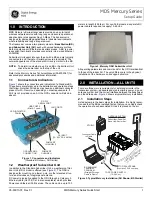
LIN bus DB-9
Wiring Harness
Conne ctor
(LIN, VBA T, GND,
and CANH/CANL)
LIN Bu s Signa l
Heade r
LIN Bu s Wiring
Terminal Block
LIN Sig nal Ro utin g
Sele ction Jumper
LIN Maste r Mode
Conne ction Ju mp er
TVS Di ode and
Loa ding
Capacitors
TLIN202 9-Q1
LIN
RX & TX
LIN
Ena ble
Hardware description
8
SLLU216 – July 2019
Copyright © 2019, Texas Instruments Incorporated
SPI to CAN FD SBC + LIN Transceiver BoosterPack User's Guide
2.2.5
Common-Mode Choke
Many applications have system-level electromagnetic compatibility (EMC) requirements that may require
the use of a common-mode choke on the CAN pins. A typical common-mode choke pad has been added
to the BoosterPack for the user to add their desired choke. However, by default, 0-
Ω
resistors have been
placed across the choke pins to connect the CANH and CANL pins of the TCAN4550-Q1 device with the
rest of the CAN bus connectors and features of the BoosterPack. To add a choke to the BoosterPack,
simply remove resistors R10 and R15 from the BoosterPack and install the choke in their place.
2.2.6
Clocking
The TCAN4550-Q1 requires either a crystal oscillator or a single-ended clock to run its digital core. A 40-
MHz crystal oscillator is installed and connected to the OSC1/CLKIN and OSC2 pins by default and is
available whenever the V
IO
3.3-V supply is present. CAN FD data rates of 2 Mbps or greater require a
clock frequency of 40 MHz to generate a time quanta small enough to allow for accurate data sampling of
CAN bits. For slower applications with data rates < 2 Mbps, the crystal could be replaced with a 20-MHz
version if desired, but the 40-MHz crystal is still recommended.
Since a 40-MHz single-ended clock source is not commonly available on most LaunchPads, there is no
provision on the BoosterPack to support a single-ended clock and the TCAN4550-Q1 must rely on the
crystal oscillator for its clock source.
2.3
LIN
The following sections describe the components and features of the LIN bus.
Figure 4. LIN bus components and features









































